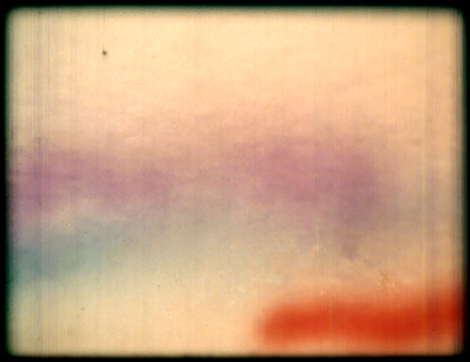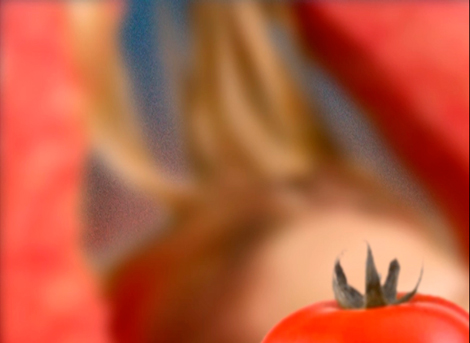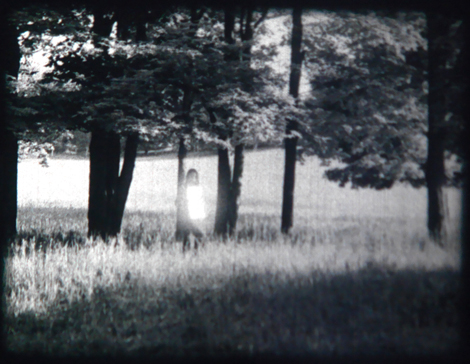A special place exists within those fleeting moments transitioning from slumber into an awakened state. In those few seconds when dreamscape combines with reality, both a mild confusion and an eerie comfort sets in. Our mind sifts, sorts and makes sense of what is imagined vs. what is real. Images seem familiar, yet somewhat distant and askew. This is how best to describe the films from Victoria Fu’s exhibition at UC Irvine’s Art Gallery, “Cult of Splendor.”
Fu is an artist currently on fire after being announced as one of the participating artists for the 2014 Whitney Biennial. She will also be featured regionally in the next major exhibition at the UCR’s California Museum of Photography, “Trouble with the Index.”
Fu’s work transitions seamlessly from photo to film, with “The Cult of Splendor” being solely a film exhibition. Upon entering the large, darkened gallery, the viewer is met with an expansive freestanding wall upon which is projected the primary work of the exhibition, Belle Captive I (2013). This work dominates the space, bleeding off of the right side of its main projection surface and spilling onto the back wall of the gallery.
Belle Captive I blends digital video and analog film, with imagery combining both original and appropriated content. In the foreground is generic stock footage taken from the Internet—a bright yellow bird, a hand moving across the screen, the top of a young man’s head, a tomato slowly spinning in the corner. This footage is digitally overlaid on brightly colored, modulating backgrounds, the original content for which were filmed as 16 mm abstractions. The feeling is akin to watching a cinematic movie with a multitude of green screen shots, with foreground distinct from the background. Attractive, yet unnatural at the same time, this technique leads to an uncanny familiarity and uneasiness.
Fu’s “Cult of Splendor” is split into two very distinct halves, the front being dominated by Belle Captive I. After passing the freestanding wall that Belle Captive I occupies, the back half of the exhibition contains two smaller works, Three Breaths and Milk of the Eye (both 2012). These two films are projected in a much smaller format using vintage 16 mm projectors. With their winding loop of exposed filmstrips and highly repetitive sound, the projectors lend the feel of an installation. At the Jack Goldstein exhibition at OCMA in 2012 or, for example, in the room adjacent to Mike Kelley’s Extracurricular Activity Projective Reconstruction #1 (2000) at MoMA, the use of such projectors resulted in viewers spending as much time investigating the object on the pedestal as they did watching the film. Within the context of “Cult of Splendor” these projectors seem much more natural, even essential as they add both a subtle soundtrack and also help contextualize the analog films. They provide a tangible grounding effect to the otherwise abstract, dreamlike quality of the two silent films.
Both Three Breaths and Milk of the Eye are much more subtle works than Belle Captive I. Milk of the Eye is a grainy black-and-white film, reminiscent of something out of a horror movie. A nondescript woman, out of focus, walks along a path slowly through the woods toward the viewer. The footage is choppy and jumps between several distinct clips of the woman, created by the splicing of multiple different filmstrips in true analog fashion. The woman’s face is primarily out of view—blocked by a large mirror that repeatedly catches the light, shining it back toward the camera, resulting in explosive blasts of white on the screen. The film ends abruptly, leaving only the mind of the viewer, wanting to create narrative.
Three Breaths is an abstract film—akin to zooming in on a slowly morphing Impressionist painting of a sunset with bright yellows, oranges and reds undulating throughout the 2-minute loop. Through the duration, growing black masses that enter from the edge of the screen slowly overtake the colors. A final flash and suddenly the vivid impressionistic imagery is gone. An out of focus shot of the desert remains. As Hunter S. Thompson wrote in Fear and Loathing in Las Vegas, “What the f::: are we doing out here in the desert?”
Beautiful yet baffling, similar to the warm confusion felt when waking from a deep slumber in an unfamiliar, unremarkable location, Fu’s work leaves us to wonder when exactly the dream ends and reality begins.




